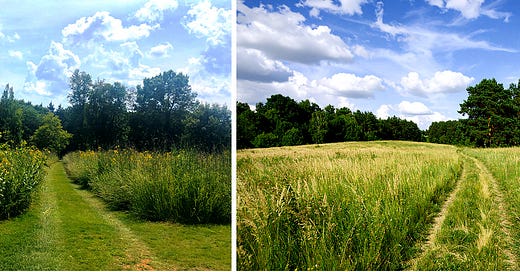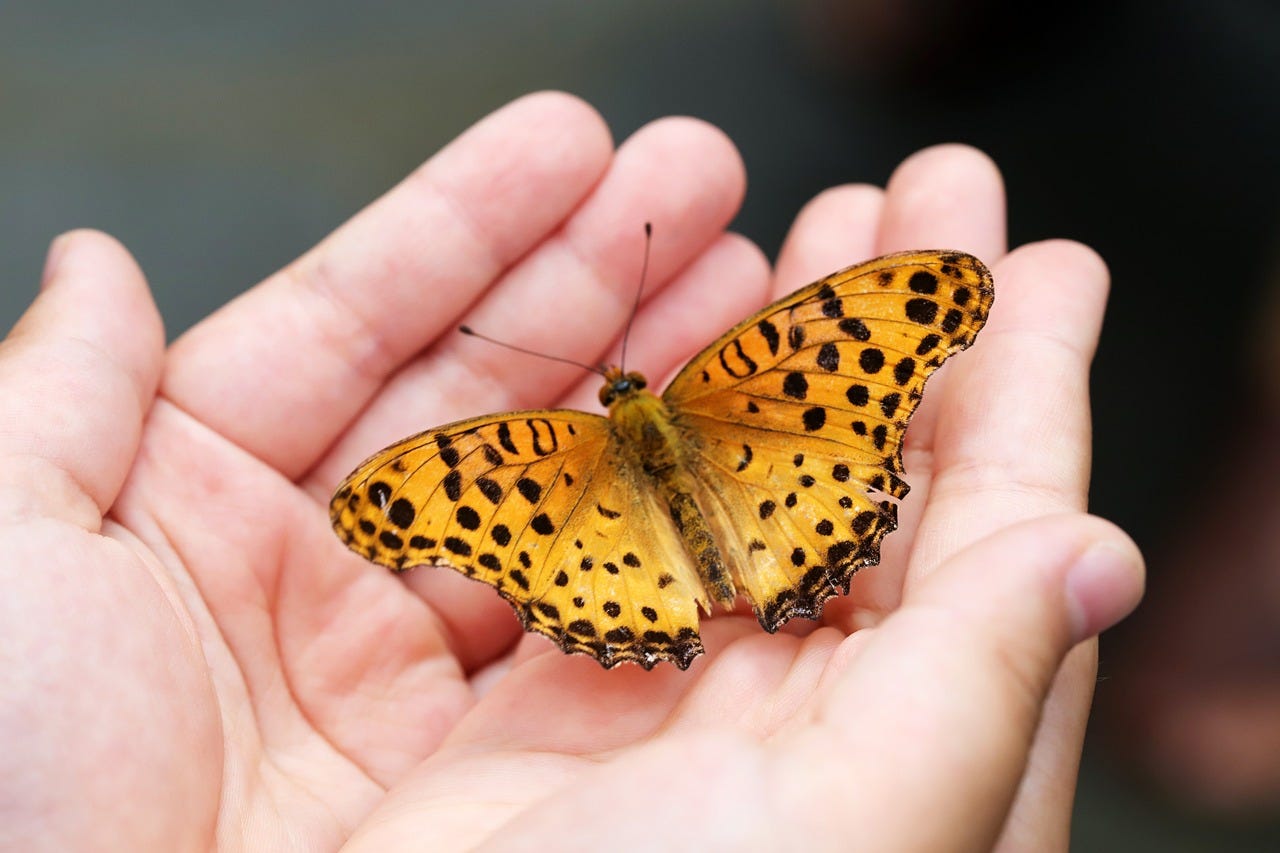If you liked reading this, feel free to click the ❤️ button on this post so more people can discover it on Substack 🙏
Welcome!
For those new here, Hedge Mystic is a reader-supported publication where I explore spiritual topics in parallel with seasonal wisdom and creative practice.
All of my articles are free to read, but you can send me a one-time donation if you like my work, book a tarot reading, or upgrade your subscription to support me long-term.
Buckle up because I’m going to do something today that I never do…talk about current events. Uh-Oh. Not politics, (sigh of relief) but current events nonetheless.
A few days ago, the French President’s wife smacked him in the face, and it was caught on live TV. Immediately, a reporter called the French equivalent of the White House and asked for a statement. He was told that the entire incident was fake, an AI video created by Russia. The reporter pushed back, telling them that the incident was caught on live TV and seen by millions of people. Apparently, the PR staff was unaware that the interaction was captured on live TV and streamed worldwide. They instantly backed off that explanation and crafted a new narrative, which they continue to stick to.
Now, I don’t care about the French President and his wife, and I’m not particularly interested in this situation. However, I'm incredibly concerned that the knee-jerk reaction was to immediately discredit an embarrassing incident by claiming it was AI-generated by an adversary.
My concern level is high because Google released the first demos of Veo 3, an AI-generated video creator, this past week. If the demos haven’t crossed your social media feed yet, they will. To the average person, absentmindedly scrolling or half watching TV across the room, these videos are practically indistinguishable from real videos/films/interviews/sitcoms/commercials created with real people in them. Even on closer inspection, many of them pass the sniff test for the average person. I’m sure if your profession is video production, you might be able to spot the AI immediately, but the average person, with or without a little distraction, would be hard-pressed to quickly identify the video as AI.
What I find the most uncomfortable to deal with is the immediate blaming of AI to discredit an embarrassing, inconvenient, compromising, or truly horrific event that we see on TV, in a photo, or on video. How easy it will be moving forward to tell the public, “That devastating bombing by xyz group or country wasn’t real, that was just AI put out by their enemies to make them look bad and sway public opinion against them.” And rest assured that this will happen: both the AI lie to cover things up, and adversaries, opponents, and enemies creating AI-generated photos and videos to frame their opposition for committing atrocities they never committed.
I find this all so unnerving because just eighteen to twenty-four months ago, I was experimenting with AI image makers to generate illustrations for this very publication, and AI was still producing melting faces, seven-fingered hands, and people with grossly elongated limbs, as well as those with three arms. In under two years, we have now progressed to AI-generated video that, at a casual glance, is hard to distinguish from real human-created video with human actors. And that’s just what the powers that be have allowed the public to have. Imagine the level of AI sophistication governments and intelligence agencies already have and have had for years.
Soon, it will become increasingly complex to distinguish what is real. When that happens, society will become unstable, as uncertainty breeds mistrust and a certain level of paranoia, as if we don’t already have enough of that. I hate to be a doom and gloomer, but human beings are notorious for needing to see things with their own eyes to know they are real and true.
AI has been present in various forms for some time already, and it’s not going anywhere; it will only become more embedded in our everyday experiences.
Check out the Car Show video created by Veo 3 AI below and ask yourself: if you were sitting in the dentist’s office waiting room, paying only mild attention to the TV on the wall, would you immediately recognize this as AI-generated content?
How do we deal with our new reality? Stemming the tide of AI is unlikely, so it will be up to each of us to figure out ways to stay firmly grounded and connected to what is real. We’ll need to sharpen our senses and intuition to discern what is real from what is not.
Make observing and noticing a priority. Nothing will sharpen your bedrock certainty of reality than close observation of nature. Nature, with all her complexity, variety, diversity, and details, will train your eye to distinguish reality. Get off your screens and start spending dedicated time looking around at the real world and AI imitations won’t easily fool you.
If you know how shadows are supposed to look in the morning, midday, and in the evening, where the moon should be throughout its lunation, how shadows from clouds look on the ground, which birds and animals should be in which habitats, the form and growing habit of common trees, the season when specific flowers bloom, the coloration of various animals usually seen in the suburbs and cities you’ll go a long way to being grounded in reality and being able to recall what is real when shown what is fake.
Being outside on our beautiful planet, watching, looking, observing, seeing, and feeling what that’s like begins to guard you against the forgery of AI. Unless you have a vast storehouse of memories of the real world, it will be more difficult to discern reality from AI illusion.
The goal is that when you see an AI rendering through a photo or video, something should immediately feel off. You may not be able to articulate it, but something seems not quite right.
For over a century, since the advent of photography to the arrival of TV in your living room, and smartphones with cameras and video, we’ve become accustomed to seeing copies of reality. Technology continues to advance, and for those who remember the "Is it live or is it Memorex?" commercial, our store of memories, which includes direct experiences of reality, has become muddled with copies that challenge our ability to intuitively know when something isn’t real.
One of the most human things we can do, besides spending time with those we love and are closest to, is to spend time outdoors in nature. Actual, not virtual, experiences in nature build our abilities of perception, recognition, hearing, sight, smell, and perhaps, most importantly, a deep, reinforcing inner sixth-sense of what is real. The whole-body experience of being outdoors, including exposure to the Earth’s electromagnetic field and other Earth energies, is crucial. Visual memories of how trees move in the breeze, how clouds form and dissipate, shadows dispersing as they move further from the object casting the shadow, as well as auditory memories of the sound of flowing water and falling rain, need to be firmly embedded in memory so we can readily spot the inauthentic and the unreal.
Aside from all this, being outdoors is a tremendously powerful remedy to our increasing exposure to virtual reality. A cheap substitute never holds the depth and richness of the real thing. Watching an amazing AI-generated virtual experience of a woodland in spring pales in comparison to being there.
We are not machines. We were created for this Earth and for each other. Let’s find our way back to our loved ones and our land.
Are you moved by this piece and want the Hedge Mystic Community to benefit and grow? Then, make a one-time donation. Click the Donate button below!
Thank you for reading Hedge Mystic and participating in this vibrant and growing community of creative, spiritual humans. You are always welcome here, appreciated, and loved.
Hedge Mystic is a reader-supported publication based on a value-for-value premise. If you find value in Hedge Mystic, support my work and consider becoming a paid subscriber. Your involvement and financial support are deeply appreciated. Thank you.







Thanks Jan. Well written and great observations
I honestly feel like all war is dishonest to a certain extent. To do what drone operators have to do? Doesn’t even look real. Yes, we have to be hyper alert and teach one another. The truth is out there and many have died getting it.